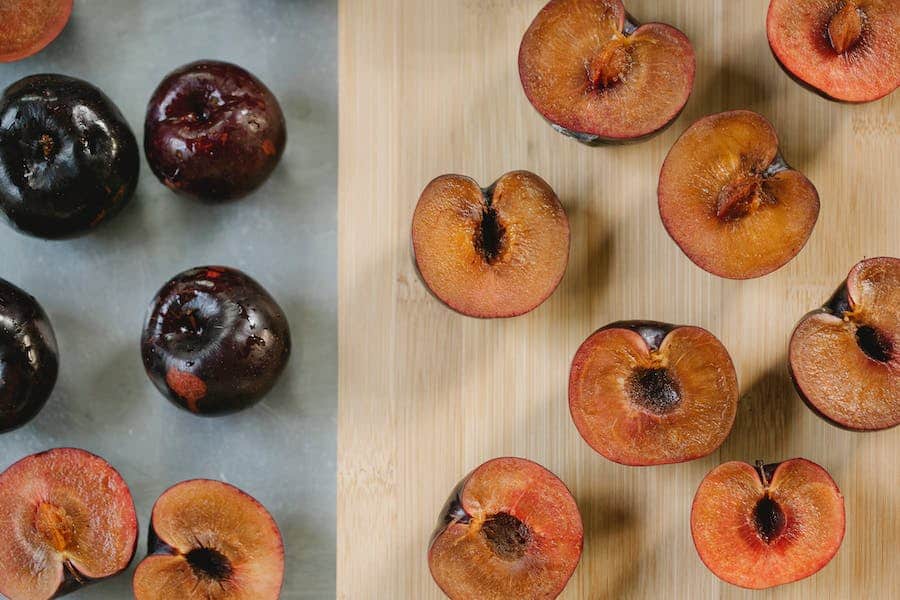The color of a plum, seemingly a straightforward inquiry, unveils a world of complexity and diversity within the realm of this delectable fruit. Plums, with their juicy flesh and sweet-tart flavor, come in an astonishing array of colors, from deep purples to vibrant reds, golden yellows, and even greens. The hues of plums are not just visually appealing but also indicative of various factors such as the type of plum, its ripeness, and the season in which it’s harvested. In this article, we will delve into the intriguing world of plum colors, exploring why they vary, when plums are in season, how different plum types exhibit unique hues, and the culinary and visual significance of this diversity. So, let’s embark on this flavorful journey and answer the question, “What color is a plum?”
What Color Is A Plum?
Plums can be various colors, including deep purple, red, yellow, and green. The specific color depends on the type of plum, its ripeness, and growing conditions. While most plums are known for their purple or red hues, certain varieties may be yellow when ripe, and unripe plums can appear green. The color of a plum is a combination of these factors and can vary significantly.
The Variability Of Plum Colors
Plums, despite their relatively small size, exhibit a remarkable range of colors. This variability is influenced by several key factors that interact to create the distinct hues we associate with these fruits.
- Type Of Plum: One of the primary factors contributing to the diversity in plum colors is the type or variety of plum itself. Different plum varieties have genetic characteristics that result in varying skin and flesh colors. For instance, the iconic Santa Rosa plum typically boasts a vibrant red or deep purple exterior, while the Mirabelle plum tends to be yellow.
- Ripeness: Plum color can change significantly as the fruit ripens. While many plums start as green when unripe, they transition to their final color as they mature. This transformation is most evident in plums with purple or red hues, which deepen and become more vibrant as they become riper. Thus, the same plum can appear green, yellow, or red at different stages of ripeness.
- Growing Conditions: The environment in which plums are grown also plays a role in determining their color. Factors such as soil composition, temperature, and sunlight exposure can influence the pigmentation of the fruit. Plums grown in cooler climates may exhibit darker, more intense colors compared to those grown in warmer regions.
- Variability Within Colors: Even within a particular color category, such as purple, there is a wide spectrum of shades. Some plums may be almost black, while others are more reddish-purple or violet. This subtle variation in color can be attributed to genetic diversity within plum varieties and their individual responses to environmental factors.
How Different Types Of Plums Have Distinct Colors
The world of plums is rich with diversity, and different types or varieties of plums exhibit unique colors. This variation in plum colors is a result of their genetic makeup, and it’s one of the factors that make plums such an intriguing fruit to explore.
- Red And Purple Plums: Many plum varieties fall into the red or purple category. These plums are known for their deep and rich colors. Examples include the Santa Rosa plum, which is famous for its vibrant red or purple skin and sweet, juicy flesh. European plums like the Stanley plum are often deep purple. These plums get their colors from pigments called anthocyanins.
- Yellow Plums: Yellow plums are characterized by their sunny, golden-hued skin. Varieties like the Golden Globe plum and the Mirabelle plum are popular examples of yellow plums. Their color is a result of the absence of anthocyanin pigments and the presence of carotenoids, which are responsible for the yellow and orange colors in fruits and vegetables.
- Green Plums: Unripe plums are typically green, regardless of the ultimate color they will develop upon ripening. Green plums are tart and not suitable for eating in their unripe state. As they mature and ripen, they may change to red, purple, or yellow, depending on their variety.
- Black Plums: Some plum varieties are referred to as black plums due to their very dark, almost black, skin. The Black Diamond plum is a prime example. These plums also contain anthocyanin pigments, but their high concentration gives them their exceptionally dark hue.
- Green Gage Plums: The Green Gage plum is unique because it is both green and considered one of the best dessert plums. It is known for its small, round, and greenish-yellow fruit, which remains green even when ripe.
Culinary And Visual Appeal Of Plum Colors
Plums, with their diverse range of colors, hold a special place in both the culinary and visual realms. Their appearance and flavor make them highly appealing in various ways.
1. Culinary Delights:
Plums are celebrated for their culinary versatility, and their colors play a significant role in creating visually appealing dishes and beverages.
Desserts: The vibrant hues of red, purple, and yellow plums make them ideal ingredients for a wide array of desserts. Plum tarts, cobblers, crisps, and cakes are not only delicious but also visually striking, with the plum’s natural colors adding a burst of vibrancy to the dish.
Preserves And Jams: The natural sugars in plums, combined with their colors, result in stunning homemade jams and preserves. Whether it’s red plum jam or golden marmalade, these preserves are a feast for the eyes and taste buds.
Salads: Sliced plums, with their contrasting colors, can elevate salads both in terms of taste and presentation. They add a sweet and tart note, as well as a pop of color to green salads.
Beverages: Plums are used in making colorful and flavorful beverages such as plum juice, plum-infused water, and cocktails. Their vibrant colors make these drinks visually appealing and refreshing.
2. Visual Appeal:
Beyond their role in the culinary world, plum colors have visual appeal in other contexts as well.
Aesthetics In Gardens: Plum trees, with their colorful fruits, can be ornamental additions to gardens. The sight of plum trees laden with plums in various stages of ripeness is a picturesque one, often capturing the essence of late summer.
Interior Decor: Plum colors, inspired by the fruit itself, have found their way into interior design. Plum-colored furnishings, accessories, and paint shades can add warmth and sophistication to living spaces.
Fashion And Art: Plum colors, whether deep purple or soft lavender, are popular choices in fashion and art. These shades are associated with elegance, luxury, and creativity, making them sought after in clothing, accessories, and artistic expressions.
Conclusion
In conclusion, the question “What color is a plum?” unveils a captivating world of diversity within this beloved fruit. Plums come in an array of colors, from deep purples and vibrant reds to golden yellows and even greens. This variability is shaped by factors like plum type, ripeness, and environmental conditions. The distinct colors of plums not only enhance their culinary appeal, adding vibrancy to dishes and beverages, but also hold aesthetic significance in gardens, interiors, fashion, and art. Embracing the kaleidoscope of plum colors reminds us of nature’s beauty and culinary delights.
FAQ’s
Can Plums Be Green When Ripe?
Yes, some plum varieties, like the Green Gage plum, remain green even when fully ripe, offering a unique and sweet-tart flavor profile.
Why Do Plums Change Color As They Ripen?
Plums change color due to the breakdown of chlorophyll and the development of pigments like anthocyanins and carotenoids, which vary by variety and ripeness.
Are Black Plums Truly Black?
Black plums are very dark, often appearing almost black, but they are actually a deep shade of purple or red, attributed to high levels of anthocyanin pigments.
Do Plum Colors Affect Taste?
Plum colors do not significantly impact taste, but they can influence our perception of sweetness and ripeness. Ripe plums are generally sweeter, regardless of their color.
Are Green Plums Safe To Eat?
Green plums are safe to eat, but they are typically tart and sour when unripe. Most people prefer to consume plums when they have reached their mature color and flavor.








